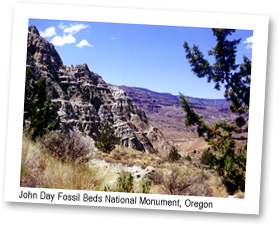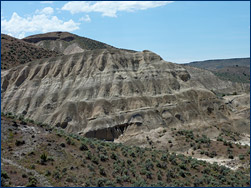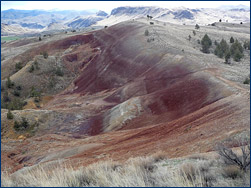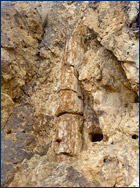|
Online exhibits : Special exhibits : Fossils in our parklands
John Day Fossil Beds National Monument, Oregon
by Kaitlin Maguire
The John Day Fossil Beds, located in Central Oregon, contain fossiliferous deposits that span over 40 million years, preserving a robust record of Cenozoic plants and mammals in the northwest US. The monument is divided into three units — the Clarno, Painted Hills and Sheep Rock — each with its own unique paleontological resources. The expansive time represented in the geology and paleontology of the park provides an excellent setting to study environmental and biotic changes through time.
The rocks and fossils of the John Day Basin are the only near continuous record of change in plant and animal life from the Pacific Northwest. They show how climates fluctuated and became cooler and drier through time and often have the oldest records of animals migrating across the Bering Straits into North America from Asia. These are also key faunas for continent-wide studies of how animals respond to climate change, such as MIOMAP, a project developed at Berkeley by Tony Barnosky and Marc Carrasco. |
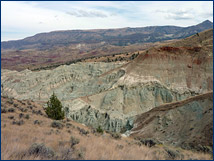 |
 |
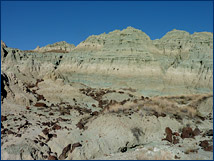 |
 |
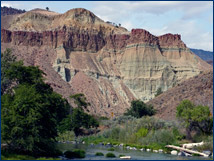 |
 |
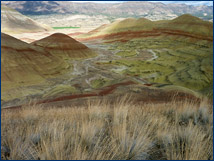 |
 |
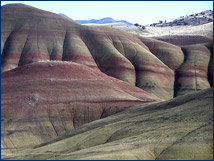 |
 |
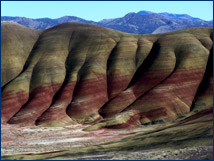 |

Click on any image on this page to see an enlargement. Top left and middle: Two views of the colorful and wonderfully eroded rocks of Blue Basin. Top right: Cathedral Rock, like Blue Basin, is in the Sheep Rock unit of John Day Fossil Beds National Monument. Bottom three: Views of the colorful layers exhibited in the Painted Hills unit. |
UCMP involvement
 |


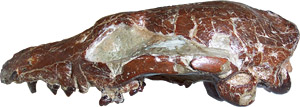

The skulls of the Oligocene horse Miohippus (top) and the fox-like canid Leptocyon (not to scale), both collected in the John Day Basin around 1900.
|
Fossils were first discovered in the John Day Basin by soldiers during the Civil War. In the 1870s several East Coast institutions sent expeditions to the area, but the first substantial collections were made by crews from UC Berkeley and led by John C. Merriam from 1899 through the 1920s. These are some of the first fossils cataloged into the Museum of Paleontology, and many became type specimens of new species and genera of plants and mammals. Ruben A. Stirton and Chester Stock (assistant professor of paleontology at Berkeley in the early 1920s), a student of Merriam, also joined field collection parties to the John Day Basin. Stock collected many specimens from the Miocene and Pleistocene deposits of the Rattlesnake and Mascall Formations during the summer of 1916. Beginning in the 1920s and continuing throughout his career, Ralph Chaney, a professor of paleontology and curator of paleobotany at UCMP, studied the flora of the John Day Basin. He collected and published on the well known Bridgecreek flora of the picturesque Painted Hills and also the Miocene Mascall flora. In the 1940s Theodore Downs, a student at the UCMP, studied the Miocene Mascall Formation, still the most comprehensive study of this Barstovian fauna. Beginning in the 1960s John Rensberger, another UCMP student, studied the stratigraphic succession of aplodontids in the Oligocene John Day Formation. Howard Hutchinson, a former vertebrate collections manager and museum scientist, studied several mammalian taxa from eastern Oregon. There are many more former graduate students and affiliates of the UCMP who studied the fossils and paleoenvironments of the area and this tradition continues today with the field work of graduate student, Kaitlin Maguire.
Researchers from the UCMP also played a role in the development of the John Day Fossil Beds National Monument. John Merriam was an early proponent for protecting the area and its resources. In the earlier part of the 1900s he organized a committee called The Associates, who were to oversee the study of the John Day Fossil Beds and ultimately to preserve the resource as a national monument. The Associates included Merriam, Earl Packard, W.S.W. Kew, J.D. Nomland, John Buwalda (a professor of geology at Berkeley in the early 1920s), Chester Stock and Bruce Clark. About 14,000 acres were finally protected in 1974 when the monument was officially established.
|
|
 |
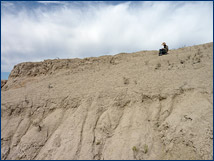 |
 |
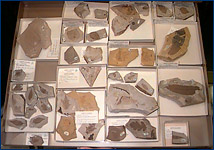 |
 |
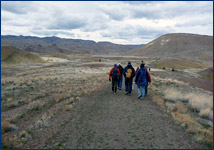 |

Top left: Exposures of the Mascall Formation. Top middle: The hills of the Clarno unit. Top right: The Hancock tree, a fossilized tree trunk in the Clarno unit that was buried in a lahar (a debris flow containing volcanic material) in an upright position. Bottom left: Undergraduate Paul Newsam looks for Miocene mammal fossils in the Mascall Formation. Bottom middle: A drawer of John Day plant fossils in the UCMP collections. Bottom right: Current and former UCMP graduate students hike through the Painted Hills unit. |
|
In the collections
Today UCMP holds more than 7000 fossil plant and vertebrate specimens collected from the John Day Basin; of these, only slightly more than 750 have been published to date. So while more than 100 papers have been published based on UCMP collections and localities, so much work remains to be done. Many John Day fossils from the UCMP collections are on display at the >Thomas Condon Paleontology Center at the Sheep Rock unit.
 |
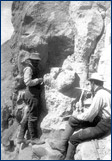 |
 |
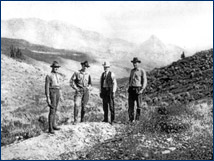 |

Left: John Merriam (left) excavating the skull of an entelodont with Loye Miller near the Painted Hills unit in 1899. Miller later become an expert on fossil birds. Right: UC Berkeley paleontologists, Eustace Furlong, Chester Stock, John Merriam and Ralph Chaney, in the Sheep Rock unit.
|
Note: Collection of fossil material is illegal unless done under a permit from the National Park Service. If you think you have found a fossil on National Park lands, please contact a park representative.
More information
According to the National Park Service's website for the John Day Fossil Beds, "… almost 6,000 manuscripts are germane to the organisms, events, and processes preserved in the John Day Basin." A small sampling of pertinent links and publications are provided here.
See the John Day Fossil Beds National Monument website.
Read about a UCMP field trip to John Day.
- A selection of UCMP fossil specimens from John Day can be found online:
- Thuja dimorpha, a conifer in the cypress family
- A North American camel
- The oreodont Merycochoerus occidentalis
- Pleurolicus sulcifrons, a pocket gopher
- Protospermophilus oregonensis, a squirrel
- Metasequoia occidentalis, the Dawn Redwood
UMCP's peer-reviewed journal PaleoBios published a number of papers on the John Day Basin between 2006 and 2009. Look for abstracts of these papers.
Albright, L.B., III, M.O. Woodburne, T.J. Fremd, C.C. Swisher III, B.J. MacFadden, and G.R. Scott. 2008. Revised chronostratigraphy and biostratigraphy of the John Day Formation (Turtle Cove and Kimberly members), Oregon, with implications for updated calibration of the Arikareean North American Land Mammal Age. Journal of Geology 116:211-237.
Anonymous. 1899. Report of the expedition to the John Day Fossil Beds. University Chronicle 2(3):217-224.
[Describes the expedition of Berkeley scientists to the John Day fossil beds in 1898.]
Chaney, R.W. 1924. Quantitative studies of the Bridge Creek Flora. American Journal of Science, 5th Series, 8(44):127-144.
[Chaney was one of the first to publish on the paleobotany of the Bridge Creek area.]
Chaney, R.W. 1927. Geology and paleontology of the Crooked River basin, with special reference to the Bridge Creek flora. Carnegie Institute of Washington Publication 346:51-53, 58-59.
Chaney, R.W. 1938. Ancient forests of Oregon: A study of Earth history in western America. Carnegie Institute of Washington, Cooperation in Research Publication 501:631-648.
Merriam, J.C. 1901. The John Day Fossil Beds. Harper's Monthly Magazine 102:610, pp. 581-590.
Merriam, J.C. 1901. A contribution to the geology of the John Day Basin. University of California Bulletin of the Department of Geology 2:9, pp. 269-314.
Merriam J.C., C. Stock and C.L. Moody. 1925. The Pliocene Rattlesnake Formation and the fauna of eastern Oregon, with notes on the geology of the Rattlesnake and Mascall deposits. Carnegie Institution of Washington Publication 347, Paper III, pp. 43-92.
Miller, L. 1899. Journal of the first trip of University of California to John Day Beds of Eastern Oregon. J.A. Shotwell (ed.). University of Oregon Museum of Natural History Bulletin 19:1-21.
Miller, L.H. 1950. The John Day Basin of Oregon. Pp. 104-129 in Lifelong Boyhood: Recollections of a Naturalist Afield. University of California Press, Berkeley.
Sternberg, C.H. 1931. Expedition to the John Day River in 1878. Pp. 170-204 in The Life of a Fossil Hunter. Jensen Printing, San Diego.
Stirton, R.A. 1944. A rhinoceros tooth from the Clarno Eocene of Oregon. Journal of Paleontology 18(3):265-267.
Stock, C. 1946. Oregon's wonderland of the past — the John Day. Scientific Monthly 63:59-65.
Woodburne, M.O., and P.T. Robinson. 1977. A new late Hemingfordian mammal fauna from the John Day Formation, Oregon, and its stratigraphic implications. Journal of Paleontology 51:750-757.
[Woodburne received his Ph.D. in Paleontology from UC Berkeley in 1966.]
